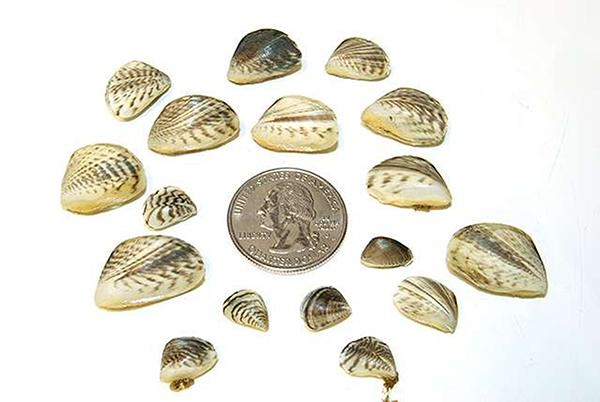By Vicki Browne
Iron County Lakes & Streams Partnership
A Taoist parable about a farmer follows a series of events that might seem good — a farmer finds a horse but have negative consequences — his son breaks his leg after being thrown. Events that might seem bad, like the broken leg, have a positive outcome — the son cannot be conscripted into the army.
The lesson being that no event in and of itself can truly be judged as good or bad, lucky or unlucky, fortunate or unfortunate. Only time can tell the full story.
Another way to look at this is through Robert K. Merton’s Law of Unintended Consequences, which states that any action has results not part of the original purpose. Those results may or may not be foreseeable. They may be beneficial, harmful or neutral.
Research into invasive mussels, specifically zebra mussels and quagga mussels, revealed a lot of helpful information, many unintended consequences, and some outcomes that could be good or bad — depending on how the story unfolds.
Zebra mussels and quagga mussels are both freshwater mollusks that reproduce with alarming frequency and firmly affix themselves to surfaces in alarming quantities.
Both have striped shells that are about the size of a dime — quagga mussels can be slightly larger. Zebra mussels have a flat bottom and won’t fall over. Quagga mussels are more rounded and will topple over.
Neither mussel is native to the U.S. Both were brought here in ballast water on transatlantic vessels. Zebra mussels were discovered in the Great Lakes in 1988 and quagga mussels in 1989. Only Lake Superior has not been infested, because it is too cold and lacks the calcium these mussels need to build their shells.
“The species, native to the Caspian and Black Sea regions, was famous on the other side of the Atlantic for its ability to glue itself to any hard surface in wickedly sharp clusters that bloody boaters’ hands and swimmers’ feet, plug pipes, foul boat bottoms and suck the plankton — the life — out of the waters it invades,” Dan Egan reported in a 2014 article for the Milwaukee Journal Sentinel, summing up the problems with zebra mussels.
These mussels have made their way into innumerable lakes and streams by attaching themselves to boats and equipment that aren’t properly cleaned, drained and dried, or as microscopic larvae (called veligers) in bilges, ballast tanks and live wells. This is why it is vitally important to always clean, drain and dry watercraft and equipment. It is also recommended that, once dry, watercraft and equipment not be transported to another water body for five days. This ensures any missed zebra or quagga mussels die from lack of moisture.
Zebra and quagga mussels are ‘filter feeders’. This means they suck in lake or stream water — up to one quart per day — and eat all the algae and phytoplankton before releasing particle-free water back to the lake or stream.
Two consequences: First, the water is clearer and more transparent, which seems like a good thing. Second, phytoplankton — which is vital food for larger organisms — isn’t available, because the invasive mussels have consumed it. This is definitely bad news for all prey fish farther up the food chain!
In 2014, the Milwaukee Journal Sentinel detailed research by Martin Meder, then a senior at the University of Wisconsin Oshkosh, that demonstrated clearer lake water increased property values by 10%. If you are selling, that’s good news.
On the other hand, clearer water allows sunlight to penetrate deeper into lakes. In lakes that have higher nutrient levels, increased sunlight will encourage algal blooms — which are definitely undesirable, and sometimes toxic.
In an earlier article, I wrote about phosphorus — the primary limiting factor for aquatic plant growth. Too much phosphorus leads to too much weedy plant growth. Zebra mussels and quagga mussels take in phosphorus, lessening the amount available in the lake. For some lakes, this could be seen as an unintended solution to the costly problem of excess phosphorus.
A PBS series called “Great Lakes Now” has a segment that describes how native fish like smallmouth bass and walleye are learning to survive in the new ecosystem created by invasive quagga mussels that cover lake bottoms and threaten the fishes’ food supply. The link is another invasive species, the round goby. Bass and walleye are learning how to catch these speedy fish.
On the other hand, round gobies are aggressive and extremely productive. They spawn every two weeks from May to September. Native species spawn mostly in the spring and so are at a disadvantage. Round gobies do eat zebra and quagga mussels, but they also eat the young and eggs of other fish. Two wrongs — invasive mussels and invasive gobies — are not necessarily making something right, but in some cases the changes aren’t all bad.
Because eradicating zebra and quagga mussels is not easy, the consequences of their presence and rapid proliferation in the Great Lakes and local lakes will continue to evolve.
Vigilant prevention on lakes where zebra and quagga mussels have not been found will keep drama at bay. For lakes that have not been as fortunate, the unintended consequences will probably be often bad, occasionally adaptively good and always relative to whatever comes next.
The Tao of invasive mussels
Image
Body


